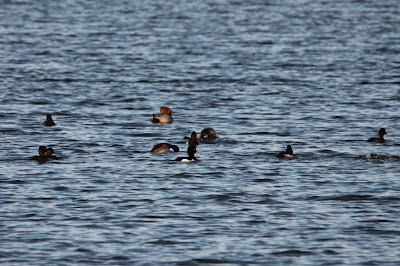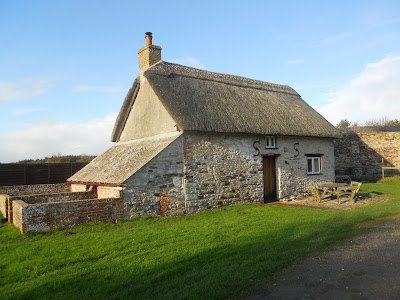The plan on this sparkling sun yet chilly day was to circumnavigate Poole Harbour, quite a thing to do in itself considering it's the second largest natural harbour in the world. The sights and scenes that can be experienced in this region can be unparalleled, but first there was the small matter of viewing that 'rare' duck again.
Literally a 10 minute drive to Longham Lake where first to fall to the binoculars were a group of Tufted Ducks with the odd Pochard. There were, as usual, several Grey Heron, Cormorants, Mallard and Black-headed Gull, along with a few
 Great Crested Grebe,
Great Crested Grebe,a skein of Canada Geese (no matter the provenance, don't you just 'love' all geese in flight?).
Not that they shouldn't be here but it was my first taste of Reed Bunting at this site,
as were probably less expected a small flock of 10 Black-tailed Godwit overflying. There were a couple of bird watchers in the same spot that the Duck was seen on Saturday, always a good sign, but the sun, directly ahead wasn't really helping. How dare I moan at a December sun?
The Blue-winged Teal was still there, still in company with the female Shoveler,
but to get half a decent shot I had to shift position, and wait for it to come to me!
wait for it to come to me!From here it's less than half an hour to reach the shore of Poole Harbour, where my first view was across the waves to Brownsea Island probably best remembered as being the very spot the Boy Scout Movement was formed.
Boarding the Sandbanks Chain Ferry, it was across the very narrow mouth of the harbour to Shell Bay.
From here you get a fairly close look at Furzy Island complete with it BP Drilling Rig, and where on occasion you can 'scope the Landing Slip (centre shot) and see Golden Pheasant.
 Looking back you get a fuller view of Sandbanks
Looking back you get a fuller view of Sandbankswhich has recently been described in the Financial Times as the most expensive Real Estate in the world. It may be of interest (right clicking this image to expand) that the house sat between the 'blue roof' house and the 'new construction' belongs to Football Manager Harry Redknapp, his son Jamie lives close by.
 In the far distance is the Isle of Wight and in the
In the far distance is the Isle of Wight and in theopposite direction Bournemouth. Looking for a Velvet Scoter (a type of stocky Sea Duck) I visited Bramble Bush Bay and beyond
and first sighted a lone Little Egret with close by
a fair number of Oystercatcher.
 Looking up, there were 7 Red Knot flying overhead,
Looking up, there were 7 Red Knot flying overhead,which landed on the foreshore not too far away but,
they only needed one look at me before beating a hasty retreat!
Looking back from Gerry's Point a better view can be had of the Chain Ferry, and also there was a single
 Grey Plover
Grey Ploverwhich took the same view as the Knot, heading off into the distance,
showing as it did so the 'trade mark' dark under-wing patches synonymous with this species.
Quickly on to Studland, probably most noted for 'nude bathing' (hang on I'll just wipe the condensation off my bins),
and a couple of Fungi on the way, it only took a matter of minutes to locate a
 Ring-necked Parakeet.
Ring-necked Parakeet.We are very lucky to have a small population of these raucous Parrots in Dorset, and as a wild but feral, self sustaining breeding group they are noted by the British Trust for Ornithology as Category C.
The best way to find these birds is usually to listen for their loud squawking, but today this loan bird remained silent so I was lucky to find it.
 Finally, via Corfe Castle,
Finally, via Corfe Castle,I visited Middlebere and the small hamlet of just 4 cottages, straight out of a Thomas Hardy novel
and now let to visitors to the county by the National Trust.
From this view sat in the 'hide', I was hoping to see a few hundred Avocet but there were none here during my visit.
All that were seen were many dozens of Lapwing along with similar numbers of Starling,
a distant Yellow-legged Gull,
lots of Brent & Canada Geese on the meadows and a few Teal, Shelduck and Wigeon.





























No comments:
Post a Comment